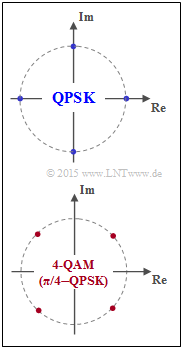Exercise 4.Ten: QPSK Channel Capacity
Given are the AWGN channel capacity limit curves for the modulation methods
- Binary Phase Shift Keying (BPSK),
- Quaternary Phase Shift Keying (4–PSK or QPSK).
The channel capacities $C_\text{BPSK}$ and $C_\text{QPSK}$ simultaneously indicate the maximum code rate $R_{\rm max}$ , with which the bit error probability $p_\text{B} ≡ 0$ can be asymptotically achieved with BPSK (or QPSK) with suitable channel coding.
The upper diagram shows the dependence on the parameter $10 \cdot \lg (E_{\rm B}/{N_0})$ in $\rm dB$, where $E_{\rm B}$ indicates the "energy per information bit".
- For large $E_{\rm B}/{N_0}$ values, the BPSK curve provides the maximum code rate $R ≈ 1$.
- From the QPSK curve, on the other hand, $R ≈ 2$ can be read.
The capacitance curves for digital input (each with the unit "bit/symbol"),
- green curve ⇒ $C_\text{BPSK} (E_{\rm B}/{N_0})$ and
- blue curve ⇒ $C_\text{QPSK} (E_{\rm B}/{N_0})$
are to be related in subtask (3) to two Shannon limit curves, each valid for a Gaussian input distribution:
- $$C_1( E_{\rm B}/{N_0}) = {1}/{2} \cdot {\rm log}_2 \hspace{0.1cm} ( 1 + \frac { 2\cdot R \cdot E_{\rm B}}{N_0}) ,$$
- $$C_2( E_{\rm B}/{N_0}) = {\rm log}_2 \hspace{0.1cm} ( 1 + \frac { R \cdot E_{\rm B}}{N_0}) .$$
The two curves simultaneously indicate the maximum code rate $R_{\rm max}$ with which error-free transmission is possible by long channel codes according to the channel coding theorem . Of course, different boundary conditions apply to $C_1( E_{\rm B}/{N_0})$ or $C_2( E_{\rm B}/{N_0})$ . Which ones, you shall find out.
On the other hand, the abscissa in the lower diagram is $10 \cdot \lg (E_{\rm S}/{N_0})$ with the "energy per symbol" $(E_{\rm S})$. Notice that the two limits are not changed from the upper plot::
- $$C_{\rm BPSK}( E_{\rm S}/{N_0} \to \infty) = C_{\rm BPSK}( E_{\rm B}/{N_0} \to \infty) = 1 \ \rm bit/symbol,$$
- $$C_{\rm QPSK}( E_{\rm S}/{N_0} \to \infty) = C_{\rm QPSK}( E_{\rm B}/{N_0} \to \infty) = 2 \ \rm bit/symbol.$$
Hints:
- The task belongs to the chapter AWGN channel capacity with discrete value input.
- Reference is made in particular to the page Maximum code rate for QAM structures.
Questions
Solution
(1) The diagram shows the signal space constellations for
- Quaternary Phase Shift Keying (QPSK), and
- four-level quadrature amplitude modulation (4–QAM).
The latter is also referred to as π/4–QPSK . Both are identical from an information-theoretic point of view ⇒ answer NO.
(2) Correct is the proposed solution 1:
- The 4–QAM can be viewed as two BPSK constellations in orthogonal planes, where the energy per information bit $(E_{\rm B})$ is the same in both cases.
- Since, according to subtask (1) the 4–QAM is identical to the QSPK, in fact:
- $$C_{\rm QPSK}( E_{\rm B}/{N_0}) = 2 \cdot C_{\rm BPSK}( E_{\rm B}/{N_0}).$$
(3) In the lower graph, the two Shannon boundary curves given are sketched together with $C_{\rm BPSK}( E_{\rm B}/{N_0})$ and $C_{\rm QPSK}( E_{\rm B}/{N_0})$ :
- $$C_1( E_{\rm B}/{N_0}) = {1}/{2} \cdot {\rm log}_2 \hspace{0.1cm} ( 1 + \frac { 2 \cdot R \cdot E_{\rm B}}{N_0}) ,$$
- $$C_2( E_{\rm B}/{N_0}) = {\rm log}_2 \hspace{0.1cm} ( 1 + \frac { R \cdot E_{\rm B}}{N_0}) .$$
One can see from this sketch: Proposed solutions 1, 2 and 4 are correct.
- The green–dashed curve $C_1( E_{\rm B}/{N_0})$ is valid for the AWGN channel with Gaussian distributed input.
- For code rate $R =1$ , $10 \cdot \lg (E_{\rm B}/{N_0}) = 1.76\ \rm dB$ is required according to this curve.
- For $R =2$ , on the other hand $10 \cdot \lg (E_{\rm B}/{N_0}) = 5.74\ \rm dB$ is required.
- The blue–dashed curve $C_2( E_{\rm B}/{N_0})$ gives the Shannon limit for $K=2$ parallel Gaussian channels. Here one needs $10 \cdot \lg (E_{\rm B}/{N_0}) = 0\ \rm dB$ for $R =1$ or $10 \cdot \lg (E_{\rm B}/{N_0}) = 1.76\ \rm dB$ for $R =2$.
- The one–dimensional BPSK is below $C_1$ in the entire range and thus, of course, below $C_2 > C_1$.
- As expected, the two–dimensional QPSK lies below the $C_2$ limit curve relevant for it. However, it is above $C_1$ in the lower range $($up to almost $\text{6 dB)}$ .
(4) The $C_{\rm QPSK}( E_{\rm B}/{N_0})$ curve can also be constructed from $C_{\rm BPSK}( E_{\rm B}/{N_0})$, namely
- on the one hand by doubling:
- $$C_{\rm BPSK}(10 \cdot {\rm lg} \hspace{0.1cm}E_{\rm S}/{N_0}) \hspace{0.3cm}\Rightarrow \hspace{0.3cm} 2 \cdot C_{\rm BPSK}(10 \cdot {\rm lg} \hspace{0.1cm}E_{\rm S}/{N_0}) ,$$
- as well as by a shift of $3\ \rm dB$ to the right:
- $$C_{\rm QPSK}(10 \cdot {\rm lg} \hspace{0.1cm}E_{\rm S}/{N_0}) = 2 \cdot C_{\rm BPSK}(10 \cdot {\rm lg} \hspace{0.1cm}E_{\rm S}/{N_0} - 3\,{\rm dB}) .$$
- The proposed solution 1 is correct. This takes into account that with QPSK the energy in one dimension is only $E_{\rm S}/2$.


